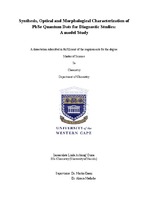| dc.contributor.advisor | Onani, Martin | |
| dc.contributor.advisor | Madiehe, Abram | |
| dc.contributor.author | Ouma, Linda Achiengꞌ | |
| dc.date.accessioned | 2015-02-13T10:01:01Z | |
| dc.date.available | 2015-02-13T10:01:01Z | |
| dc.date.issued | 2013 | |
| dc.identifier.uri | http://hdl.handle.net/11394/3975 | |
| dc.description | >Magister Scientiae - MSc | en_US |
| dc.description.abstract | In this study PbSe quantum dots (QDs) were successfully synthesized via the organometallic and aqueous routes. Optical characterization was carried out using photoluminescence (PL) spectroscopy, structural and morphological characterization were carried out using X-ray diffraction (XRD) and transmission electron microscopy (TEM). Energy-dispersive X-ray spectroscopy (EDS) was used to determine the composition of the QDs. All the synthesized QDs were found to have emissions within the near-infrared region of the spectrum (≥1000 nm) with most of them being less than 5 nm in size. The aqueous synthesized QDs had a perfect Gaussian emission spectrum with a FWHM of ~23 nm indicating pure band gap emission and narrow size distribution respectively. The QDs were determined to have a cubic rock-salt crystal structure consistent with bulk PbSe. The aqueous synthesized QDs were however not stable in solution with the QDs precipitating after approximately 48 h. The organometallic synthesized QDs were transferred into the aqueous phase by exchanging the surface oleic acid ligands with 11-mercaptoundecanoic acid ligands. The ligand exchanged QDs were however stable in solution for over two weeks. The effects of reaction parameters on the optical and structural properties of the organometallic synthesized QDs were investigated by varying the reaction time, temperature, ligand purity, lead and selenium sources. It was observed that larger QDs were formed with longer reaction times, with reactions proceeding faster at higher reaction temperatures than at lower temperatures. Varying the ligand purity was found to have minimal effects on the properties of the synthesized QDs. The lead and selenium sources contributed largely to the properties of the QDs with lead oxide producing spherical QDs which were smaller compared to the cubic QDs produced from lead acetate. TBPSe was seen to produce smaller QDs as compared to TOPSe. The cytotoxity of the synthesized QDs was determined following the WST-1 cell viability assay with the QDs being found to be non-toxic at all the tested concentrations | en_US |
| dc.language.iso | en | en_US |
| dc.publisher | University of the Western Cape | en_US |
| dc.subject | PbSe | en_US |
| dc.subject | Quantum dots (QDs) | en_US |
| dc.subject | Semiconductor nanocrystals (NCs) | en_US |
| dc.subject | Near-infrared (NIR) | en_US |
| dc.subject | Organometallic synthesis | en_US |
| dc.subject | Aqueous synthesis | en_US |
| dc.subject | Ligand exchange | en_US |
| dc.subject | Photoluminescence spectroscopy (PL) | en_US |
| dc.subject | Energy-dispersive X-ray spectroscopy (EDS) | en_US |
| dc.subject | 3-Mercaptopropionic acid (MPA) | en_US |
| dc.subject | 11-Mercaptoundecanoic acid (MUA) | en_US |
| dc.subject | Water-soluble tetrazolium salt (WST-1) | en_US |
| dc.title | Synthesis, optical and morphological characterization of pbse quantum dots for diagnostic studies: a model study | en_US |
| dc.type | Thesis | en_US |
| dc.rights.holder | University of the Western Cape | en_US |

